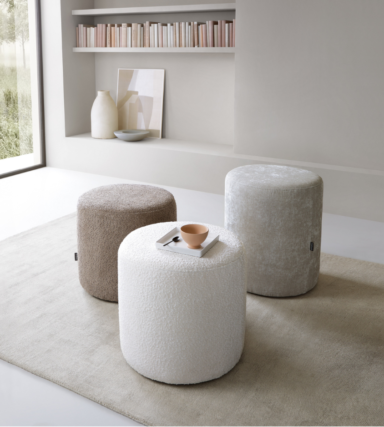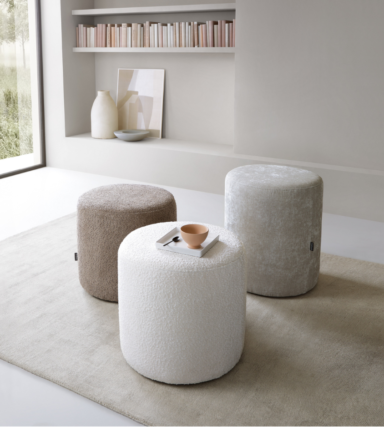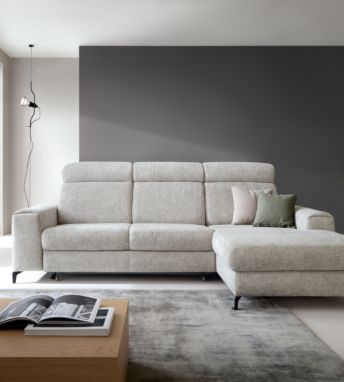Service center



- Before use
- Rules for the proper use of upholstered furniture
- Rules for proper care of fabric furniture
Before use
- Furniture should not be brought in without its packaging! The purchased furniture should be unpacked only after it has been brought into the intended room. To avoid damage to the cover and decorative elements, it is recommended to unpack the furniture carefully, without using sharp tools (adhesive tape should be removed by hand).
- Upon receipt of your upholstered furniture, please carefully inspect it for any scratches, abrasions, cracks, cuts, or other damage to the fabric structure, as well as any damage to structural or decorative elements. It is recommended to check the completeness of the furniture, i.e., whether it was delivered in accordance with your order.
- If any discrepancies or mechanical damage are found when unpacking the furniture, the original Manufacturer's packaging should be retained until the Manufacturer's service arrives and the causes of the mechanical damage are assessed.
- In the case of modular furniture, it is necessary to assemble the individual elements yourself by connecting the connectors, in accordance with the instructions included with the furniture.
- Before you start installing the legs, please read the attached instructions carefully.
- In furniture with a sleeping function, please remove the protection according to the attached instructions.
- Before use, the upholstery product must be levelled, i.e. the surface must be even.
- Any questionable operation of moving parts, such as the sleeping function, armrests, headrests, should be reported to the Seller immediately.
- Due to transportation and storage, irregular folds and creases may appear in the upholstery fabric after unpacking. This effect usually reverses within a few days of unpacking. Manual shaping of the cushions, armrests, and seats can speed up the process of removing creases from the soft elements.
- Proper conditions should be maintained in the rooms where the product is used or stored, i.e., temperatures between +15°C and +30°C, and humidity between 40% and 70%. The product should be kept at least 1 meter away from active heat sources. To prevent fading of the upholstery fabric, avoid exposing the furniture to direct sunlight.
Rules for the proper use of upholstered furniture
General care and maintenance guidelines for upholstery fabrics used in upholstered furniture. Following a few simple tips will extend the life of your furniture and ensure your satisfaction with its use.
- It's important to prevent dirt, dust, and other contaminants from remaining on the fabric's surface. It's recommended to clean the furniture once a week, using a soft vacuum cleaner attachment designed for furniture, or by hand with a soft brush. Avoid excessive rubbing and vacuuming at high power levels (over 60W) to avoid damaging the fabric fibers. It's recommended to gently shake out removable furniture parts, preferably outdoors.
- Fabrics with a napped surface, such as chenille, velvet, and flock, require regular brushing with a soft brush. This procedure will prevent the nap from pressing against the fabric's surface, especially in areas of heavy use. The nap will retain its elasticity and the fabric's softness.
- For greasy, wet stains, use tissue paper or a paper towel, followed by a clean, damp, and soft sponge, to quickly absorb the stain. Otherwise, the stain may penetrate the fabric fibers, preventing effective cleaning. Only then should you begin removing the stain, using lukewarm water and a neutral detergent designed for handwashing. Clean the stained area using gentle, circular motions from the outside in, avoiding vigorous rubbing with the wet cloth. After removing the stain, allow the fabric to air dry at room temperature. If necessary, repeat the process, expanding the area around the stain to reduce the circular effect. Brush the dried area.
- Before cleaning your furniture, test how the surface reacts to the chemical by applying it to a small, inconspicuous part of the furniture. This will prevent damage to the fabric, discoloration, or other visible deformations caused by overly aggressive action.
- Furniture with a removable cover can be washed inside out with the zipper closed (using the wool wash program) or dry-cleaned according to the care label. Fabric manufacturers recommend avoiding bleach, caustic agents, or fabric softeners, and avoid washing the cover with other materials.
- Before drying, wet covers should be stretched evenly in both directions.
- In the case of models with removable covers on the backrest, seat or decorative cushions, the fabric may become discoloured as a result of washing, causing shade discrepancies between the permanently upholstered body and the cushions.
- Upholstered furniture permanently loses the ability to be wet cleaned, so it is recommended to have the service performed by a company specializing in upholstery cleaning.
- Do not use an iron on the outside of the fabric. Spot creases can be removed with a fabric steamer.
- It is important to protect the furniture surface from pets in order to avoid irreversible damage to the structure of the upholstery fabric.
- It should be noted that covering chenille, polyester with a blend of natural fibers, or wool with pile throws may contribute to pilling, resulting from the bonding of foreign fibers with the fibers of the upholstery fabric. This pilling effect can be easily removed by using a fabric shaver.
Note: Only water-soluble cleaning agents should be used to clean upholstery fabrics. Do not use solutions containing petroleum or alcohol, such as chloroethylene or turpentine.
Rules for proper care of fabric furniture
General care and maintenance guidelines for upholstery fabrics used in upholstered furniture. Following a few simple tips will extend the life of your furniture and ensure your satisfaction with its use.
- It's important to prevent dirt, dust, and other contaminants from remaining on the fabric's surface. It's recommended to clean the furniture once a week, using a soft vacuum cleaner attachment designed for furniture, or by hand with a soft brush. Avoid excessive rubbing and vacuuming at high power levels (over 60W) to avoid damaging the fabric fibers. It's recommended to gently shake out removable furniture parts, preferably outdoors.
- Fabrics with a napped surface, such as chenille, velvet, and flock, require regular brushing with a soft brush. This procedure will prevent the nap from pressing against the fabric's surface, especially in areas of heavy use. The nap will retain its elasticity and the fabric's softness.
- For greasy, wet stains, use tissue paper or a paper towel, followed by a clean, damp, and soft sponge, to quickly absorb the stain. Otherwise, the stain may penetrate the fabric fibers, preventing effective cleaning. Only then should you begin removing the stain, using lukewarm water and a neutral detergent designed for handwashing. Clean the stained area using gentle, circular motions from the outside in, avoiding vigorous rubbing with the wet cloth. After removing the stain, allow the fabric to air dry at room temperature. If necessary, repeat the process, expanding the area around the stain to reduce the circular effect. Brush the dried area.
- Before cleaning your furniture, test how the surface reacts to the chemical by applying it to a small, inconspicuous part of the furniture. This will prevent damage to the fabric, discoloration, or other visible deformations caused by overly aggressive action.
- Furniture with a removable cover can be washed inside out with the zipper closed (using the wool wash program) or dry-cleaned according to the care label. Fabric manufacturers recommend avoiding bleach, caustic agents, or fabric softeners, and avoid washing the cover with other materials.
- Before drying, wet covers should be stretched evenly in both directions.
- In the case of models with removable covers on the backrest, seat or decorative cushions, the fabric may become discoloured as a result of washing, causing shade discrepancies between the permanently upholstered body and the cushions.
- Upholstered furniture permanently loses the ability to be wet cleaned, so it is recommended to have the service performed by a company specializing in upholstery cleaning.
- Do not use an iron on the outside of the fabric. Spot creases can be removed with a fabric steamer.
- It is important to protect the furniture surface from pets in order to avoid irreversible damage to the structure of the upholstery fabric.
- It should be noted that covering chenille, polyester with a blend of natural fibers, or wool with pile throws may contribute to pilling, resulting from the bonding of foreign fibers with the fibers of the upholstery fabric. This pilling effect can be easily removed by using a fabric shaver.
Note: Only water-soluble cleaning agents should be used to clean upholstery fabrics. Do not use solutions containing petroleum or alcohol, such as chloroethylene or turpentine.